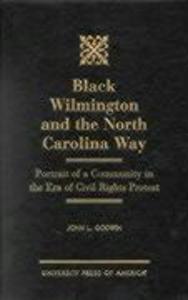
Zustellung: Di, 29.07. - Mo, 04.08.
Versand in 3-4 Wochen
VersandkostenfreiIn this gripping narrative of the development of the Civil Rights movement in North Carolina, Dr. John L. Godwin brings to life the infamous case of the Wilmington Ten and the subsequent allegations of conspiracy. Through extensive research and interviews, he seeks to uncover some of the truth behind the actual events of the 1972 trial, while at the same time drawing readers in with the compelling details of the movement's origins in North Carolina and its ultimate outcome in one community. Dr. Godwin underscores his effort with a comprehensive exploration of the Civil Rights movement through the eyes of the locality, comparing it incisively to the earlier protests of the 1960s. His portrait joins that of scholars who have sought to describe the transformation brought about by black leadership on the local and state level, recounting both its victories and the frustrated hopes of local activists, in addition to how the new conservatism ultimately succeeded in co-opting the movement. For Wilmington, this is set against the background of North Carolina politics and civic culture, highlighting the role of Benjamin Chavis and his rise to national prominence. Filled with pictures that personalize this troubled era of American history, Dr. Godwin's book is an essential resource, not only to historians but also to students of public policy.
Inhaltsverzeichnis
Chapter 1 List of Tables Chapter 2 Preface Chapter 3 Acknowledgments Chapter 4 Introduction Chapter 5 In the Shadow of Jim Crow: Black Wilmington and North Carolina Civic Culture Chapter 6 After the World Wars: The Early Civil Rights Movement Chapter 7 The Era of Brown: Massive Resistance, Black Education, and Community Mobilization Chapter 8 Entering the Mainstream: Civil Rights and the North Carolina Way Chapter 9 The Trumpet Sounds: Community Crisis and the Civil Rights Movement Chapter 10 The Walls Come Down: Political, Economic, and Cultural Transformation Chapter 11 Taming a Whirlwind: Civil Rights Leadership and the Crisis of Community Transformation Chapter 12 Conclusion Chapter 13 Afterword: Coming of Age in a New Era of Conservatism Chapter 14 Appendix Chapter 15 Notes Chapter 16 Bibliography
Produktdetails
Erscheinungsdatum
19. Juli 2000
Sprache
englisch
Seitenanzahl
464
Autor/Autorin
John L Godwin
Verlag/Hersteller
Produktart
gebunden
Gewicht
721 g
Größe (L/B/H)
235/153/29 mm
ISBN
9780761816829
Entdecken Sie mehr
Pressestimmen
... this work is a useful account of an important phase of the civil rights struggle. CHOICE ... this work is a useful account of an important phase of the civil rights struggle. CHOICE
Bewertungen
0 Bewertungen
Es wurden noch keine Bewertungen abgegeben. Schreiben Sie die erste Bewertung zu "Black Wilmington and the North Carolina Way" und helfen Sie damit anderen bei der Kaufentscheidung.







